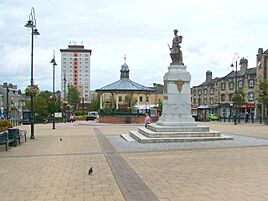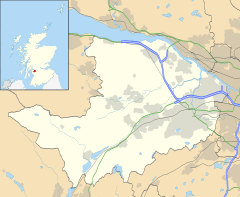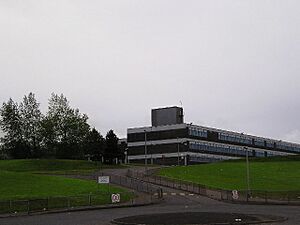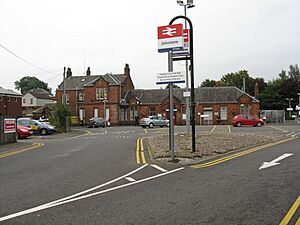Johnstone facts for kids
Quick facts for kids Johnstone
|
|
|---|---|
| Town | |
|
From top, left to right: Houstoun Square, Johnstone War Memorial, Johnstone Castle, Johnstone Parish Church, Johnstone railway station |
|
| Population | 15,930 (2020) |
| Language | English, Scots |
| OS grid reference | NS434628 |
| • Edinburgh | 52 mi (84 km) |
| Council area | |
| Lieutenancy area | |
| Country | Scotland |
| Sovereign state | United Kingdom |
| Post town | JOHNSTONE |
| Postcode district | PA5, PA6, PA9, PA10 |
| Dialling code | 01505 |
| Police | Strathclyde |
| Fire | Strathclyde |
| Ambulance | Scottish |
| EU Parliament | Scotland |
| UK Parliament |
|
| Scottish Parliament |
|
Johnstone (Scots: Johnstoun, Scottish Gaelic: Baile Iain) is a town in the area of Renfrewshire in Scotland. It is located in the west central Lowlands of Scotland.
The town is about 3 kilometres (2 miles) west of Paisley. It is also about 19 kilometres (12 miles) west of Glasgow. Johnstone is part of the larger Greater Glasgow Urban Area.
Contents
History of Johnstone
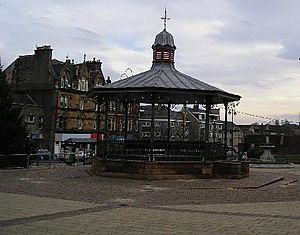
Johnstone was mostly a planned community. It grew around a house called Easter Cochrane. This house later became known as Johnstone Castle. It was the home of the Houstoun family.
In 1782, George Houstoun, who owned the land (called the Laird), planned the town's streets. These streets now form the town centre. At that time, about 1,500 people lived in the town and nearby areas.
Two public squares were built: Houstoun Square and Ludovic Square. Ludovic Square was named after the Laird's son. By 1794, the town had its own church. Johnstone became a "police burgh," which meant it had important local powers. The old court building can still be seen today.
Industry and Growth
Industries like coal mining and cotton mills brought many jobs to Johnstone. The mills used the Black Cart Water for power. A very large cotton mill was built in 1782. Robert Burns of Paisley helped this mill succeed by using new methods for spinning cotton.
As the town grew, its population reached about 5,600 by 1831. Living conditions for some workers were difficult. Improvements were made later, especially in the 1930s. New homes were built, and the town expanded.
Johnstone Castle and Modern Times
Much of Johnstone's old history has changed. The last Laird died in 1931. Johnstone Castle then fell apart and was mostly taken down in 1950. The remaining tower was bought in 2001 and is now a private home.
Where the castle grounds once were, there are now two housing areas. These are called Johnstone Castle and Cochrane Castle. The Cochrane Castle Golf Club is also located here.
In 2008, the Johnstone History Museum opened. It was the first museum in the world to be located inside a supermarket! A new Town Hall was finished in 2015.
The town is also home to the Johnstone Pipe Band. This band was started in 1943. They compete in top-level pipe band competitions.
Education in Johnstone
Thorn Public School first opened in 1904. A new Thorn Primary School opened in 1988. The old school building was taken down that same year.
In 1950, St. David's Primary School and Cochrane Castle Primary School were built. In 2007, these two schools moved into a new shared building. This building is called 'West Johnstone Shared Campus'.
Johnstone High School moved to its current location in 1965. The old building had burned down in 1960. The school's campus was rebuilt and opened again in 2009.
The original St. Cuthbert's High School was next to Johnstone High School. It closed in 1972 and moved to a new site. The old St. Cuthbert's building was later used by other schools while their own buildings were being fixed. It was also taken down in 2010.
Religion
Johnstone has churches for several Christian groups. These include three Church of Scotland churches and two Roman Catholic churches. There is also one Scottish Episcopal Church, one Evangelical church, and one Baptist church.
Sports
The town has two football teams: the Johnstone Burgh and Thorn Athletic. They play in the West of Scotland Football League.
Getting Around Johnstone
 |
Brookfield | Linwood | Paisley |  |
| Kilbarchan | Elderslie | |||
| Howwood | Gleniffer Braes | Gleniffer Braes |
Air Travel
Johnstone is close to Glasgow International Airport. This airport is about 5.6 kilometres (3.5 miles) northeast of the town. Prestwick International Airport is also easy to reach by train from Johnstone.
Roads
The A737 is a dual carriageway road. It connects Johnstone to the M8 motorway. This road helps people travel by car to central Scotland.
Bus Services
McGill's Bus Service Limited runs most of the local buses. They have many routes that serve Johnstone and nearby areas. Shuttle Buses also operate some services in the town.
Train Travel
Johnstone has two train stations. Johnstone railway station is in the east of town. It connects Johnstone to Glasgow Central, Paisley, and the Ayrshire coast.
A second station, Milliken Park railway station, is in the west end of town. The railway line follows the path of an old canal.
Famous People from Johnstone
- Sir William Arrol – He worked in Johnstone as a boy. He later designed famous bridges like the Forth Rail Bridge and Tower Bridge in London.
- Adam Brown – A professional ice hockey player. He was born in Johnstone in 1920.
- Tommy Bryce – A professional football (soccer) player.
- William Clunas – A Scottish football player. He played in an early match at Wembley Stadium.
- Hunter Davies – A journalist and author.
- John Deans – A professional football player.
- Renee Houston – A famous actress and comedian. She was born in Johnstone in 1902.
- Jim Leighton – A professional football player.
- Phyllis Logan – An actress who went to Johnstone High School.
- Annie McGuire – A BBC journalist.
- Alexander McLachlan – A poet born in 1818.
- John Pitcairn, Jr. – An industrialist from Scotland who moved to the United States.
- Gordon Ramsay – A well-known chef and TV host.
- Sir George Reid – He was the 4th Prime Minister of Australia. He also served as Australia's first High Commissioner to the UK.
- Tommy Turner – A professional football player.
- Alba Fyre - A professional wrestler.
See also
 In Spanish: Johnstone para niños
In Spanish: Johnstone para niños


